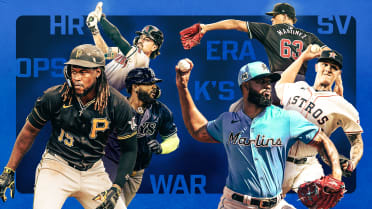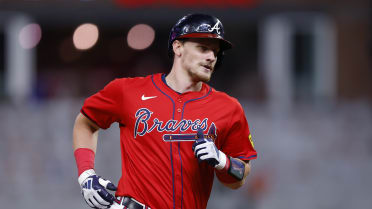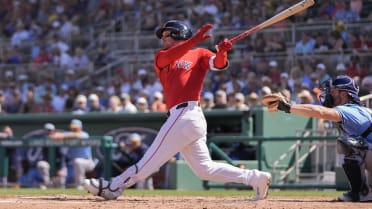How Burnes is even more dominant in 2021
Two years after 8.82 ERA, righty has 20/0 K/BB in first two starts
In 2019, Corbin Burnes had the worst pitching year in Milwaukee Brewers history. One of the worst years by anyone in any team’s history, really. The kind of year that gets you a new home or a new profession.
In 2020, he finished sixth in the NL Cy Young balloting.
In 2021, after just two starts, he's getting articles written about him comparing him to the Cy Young.
We all spent so much time trying to figure out what was "real" or not about the shortened, pandemic-affected 2020 season, what was flukish and what "mattered" enough to sustain into 2021 and beyond. Since we knew Burnes had plenty of raw talent (remember how good he looked as a reliever in 2018) and had made some real, obvious changes, we were pretty optimistic. We didn't necessarily expect this.
It's one thing to say he turned his nightmarish 2019 around, which he did. It's another thing to say he got even better between 2020 and '21, which he seems to have done. Here's what to watch from baseball's most unexpected ace as he and his Milwaukee mates face Jake Arrieta and the Cubs at home on Wednesday afternoon.
A lot has been written about how bad Burnes' 2019 was, and we won't regurgitate it all here, but if you're posting an 8.82 (!) ERA in your age-24 year, we need to at least begin there.
When we started by saying he had "the worst pitching year in Milwaukee Brewer history," that was hyperbole, maybe -- if you’re really that bad, you don’t even get the chance to stick around for 49 innings, as he did -- but he posted that 8.82 ERA, and never, not once, not even in that first year in Seattle as the Pilots, had the franchise had a pitcher throw 40 innings and get lit up that badly. It’s in the top (bottom?) 25 seasons all-time, by any pitcher who threw 40 innings. It would be remarkable, if it weren’t so painful.
It wasn't hard to see why, either. His primary pitch was his four-seam fastball. It got crushed, to the tune of a .425 batting average and an .823 slugging percentage. It got hit so hard that going back to the start of the pitch-tracking era in 2008, there have been thousands of seasons where a pitcher has had at least 100 plate appearances end on a four-seam fastball, and Burnes' 2019 wasn't the worst, thankfully. It was the second worst.
Highest wOBA against a four-seam fastball, 2008-'20
.541 -- Chris Young, 2016
.533 -- Burnes, 2019 <-------
.523 -- Félix Doubront, 2015
.513 -- Sean O'Sullivan, 2009
.511 -- Lance McCullers Jr., 2016
If this all sounds like enough to kill your career, it often is. Young, now the general manager of the Rangers, threw 30 innings the next season, the last of his career. Doubront was only 27 years old in 2015, and never pitched in the bigs again. O'Sullivan retired with a 6.02 career ERA. McCullers Jr. has been successful, of course, but like Burnes he's completely junked his four-seamer and moved on to other pitches.
There wasn't any mystery as to what was happening. The four-seam fastball Burnes had was thrown hard (95.2 MPH), but despite some very impressive spin, it was a straight and hittable pitch. If you were to look at the fastball movement leaderboard that year, you'll find his fastball had the 348th most rise of 429, and that's actually worse than it sounds; at least at the bottom, you might be getting some sink. There's really nowhere worse than being in the middle. It was straight, without much movement, aside from the hundreds of feet into the seats it regularly traveled.
So he abandoned it, mostly in favor of a cutter, but also choosing to emphasize his sinker and a slider that even in his disastrous 2019 had been very good, picking up the best swing-and-miss rate of any slider that season. (This says a lot, right here. Even in that disaster of a 2019 season, both player and team could see the bright flashing "this guy's got something!" signs under the surface.)
Burnes knew it, too, saying something provocative before the 2020 season began:
"Hey, the slider’s the best pitch in baseball. What can we do to make the slider even better but make the pitches around it even better?'”
Which is exactly what he did. We're going to crib from MLB.com's Matt Kelly here, who wrote the definitive explanation of all of this last summer.
"Burnes is dominating with an old-school mix: the sinker, the cutter and the slider," wrote Kelly. "The cutter and slider work a 1-2 punch away from right-handed hitters," while noting that his old four-seamer had been a weakness particularly against lefties. "That’s where that running two-seamer now fills the void. It’s a tunneler’s dream, as Burnes’ two-seamers break the opposite way like his cutters and sliders -- with all three pitches coming in hard and tight."
This image that Kelly created probably shows what's happening here better than any we've seen. Where everything once just sort of acted all the same, now there's real separation in his movement, all coming from the same place.
(The light blue is the curve; the yellow the slider; the dark red the cutter; the orange is the sinker; the brighter red, the four-seam.)
So now you're caught up, at least through the end of 2020. It's a tremendous story not only of an organization that stuck with a pitcher after a tremendously difficult year, but a pitcher who committed himself to completely remaking who he is. But we promised we'd show how he's still getting even better.
What's new in 2021?
Reminding you once again that Burnes posted an 8.82 ERA in 2019, just look at where he sits in a few important metrics since the start of the 2020 season (min. 50 innings pitched, so 102 pitchers) and ...
... wow, is that impressive. The pitcher who couldn't stop allowing homers two years ago now simply refuses to surrender them.
Plus, if Burnes was outstanding last year -- and he was, to the point that he might have had more support for the Cy Young if not for finishing two outs shy of qualifying for the ERA leaderboards -- he's been even better this year. So far, his two starts this year are two of his three best-ever starts as rated by Game Score.
There's clear differences here, and they're terrifying for opposing batters.
The cutter is being thrown more, and faster.
Last year Burnes threw his fastball 32% of the time at 93.1 MPH. This year, it's 49% at 95.8 MPH. It's the hardest cutter of 2020. It's the third-hardest starting pitcher cutter ever tracked, actually.
It's moving more, too.
Last year, Burnes got 10.1 inches of total movement (vertical and horizontal combined) on the cutter; this year, it's 14.1 inches. So it's moving faster and it's moving more, and maybe it's not a surprise that he's throwing it so often, or that it's so hard to hit.
Remember: Last year, Burnes' cutter was the most valuable cutter in baseball, as rated by Statcast's run values, which give credit or demerit for each time it's thrown, not just on the outcomes of the plate appearance. He's now taken that, and he's throwing it harder, with more movement, which is all deeply unfair. So far in 2021, he's thrown it 85 times and allowed just one hit (which, to be fair, was a home run, but there's hardly shame in allowing Byron Buxton to take you deep.) Just look at what it's done to a variety of Cardinals and Twins so far this year:
The slider is moving a lot more.
Last year's slider and this year's are being thrown at nearly identical velocity, but he's making it move more. Last year: 8.6 inches of total movement. This year: 11 inches. He's only thrown 18 of them so far, so perhaps a little caution is advised, but he's also gotten misses on 7 of the 10 he's thrown, so, maybe not?
He's challenging hitters more.
Last year, Burnes actually had the fourth-lowest rate of first-pitch strikes, at just under 53%. This year, that's all the way up to nearly 71%, which is the 12th-highest. And why not? When your pitches move like this, at this speed, in tandem with one another, why make things easier on the hitters?
If he keeps this up, this is going to be one of the more remarkable turnarounds in history, akin to "Roy Halladay posting a 10.64 ERA in 2000 and being an All-Star in 2002," because while plenty of great pitchers have their ups and downs on their way to the top, the downs aren't usually quite like this. (After all, many of the pitchers who pitch like Burnes did in '19 don't get a chance to prove they can do better.)
But above all, it's a very modern story. For a good portion of baseball history, an 8.82 ERA doesn't get you another chance, not with the same team. But there was also so much of interest under the hood -- between the slider, the spin, the velocity, all of the things that even publicly in the winter of 2019-'20 could be seen as appealing -- that it was worth everyone's effort to get it right. They did that, and then some. Burnes may not be Jacob deGrom just yet, but he's not all that far off, either.
Mike Petriello is a stats analyst for MLB.com, focusing on Statcast and Baseball Savant, and is also a contributor to MLB Network.




